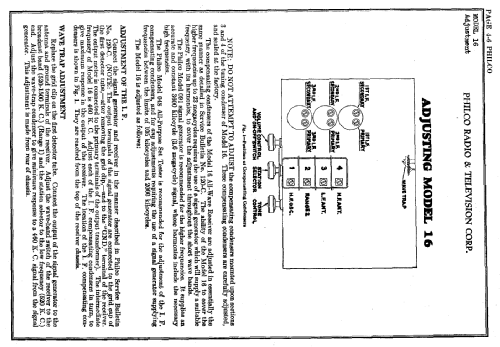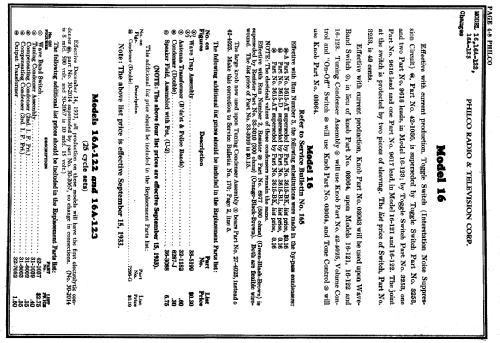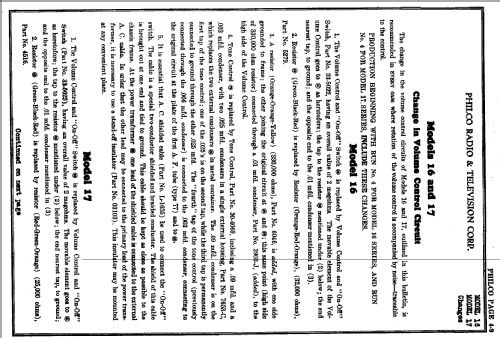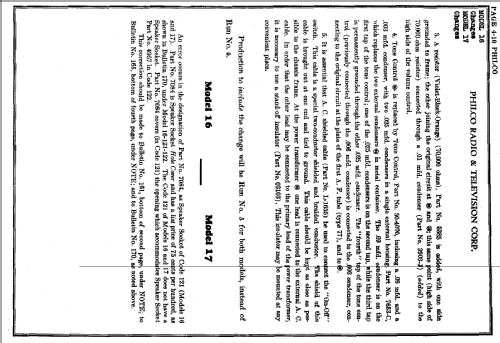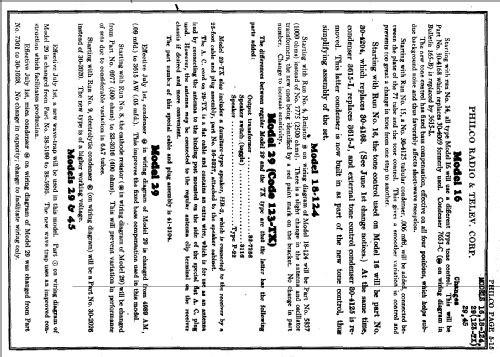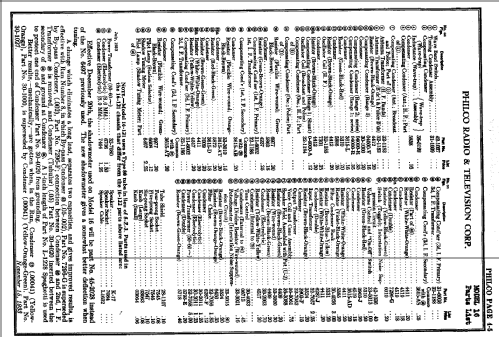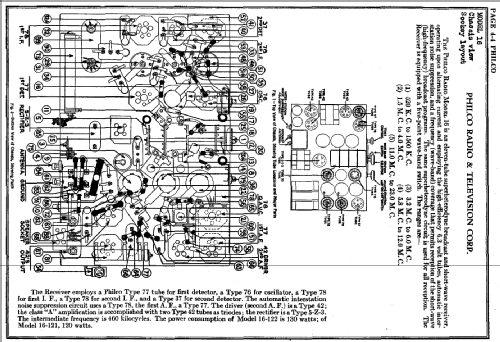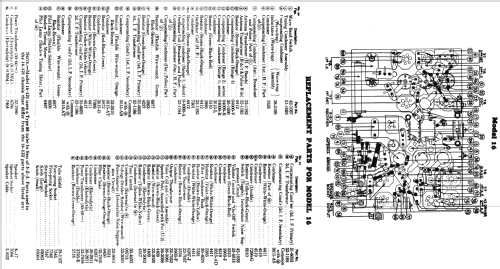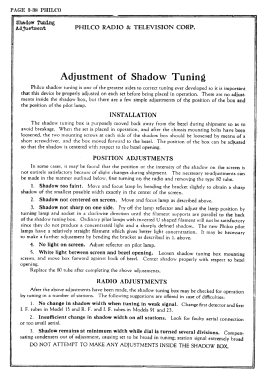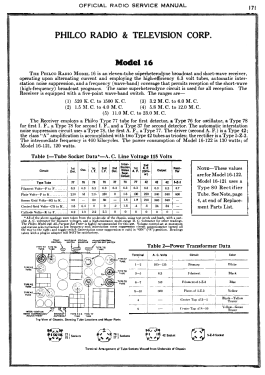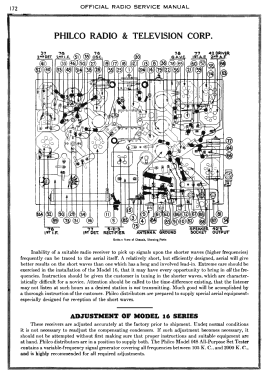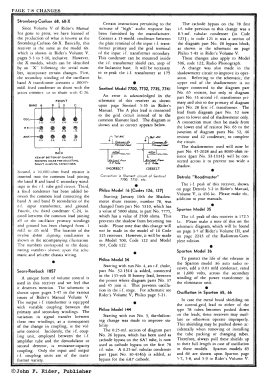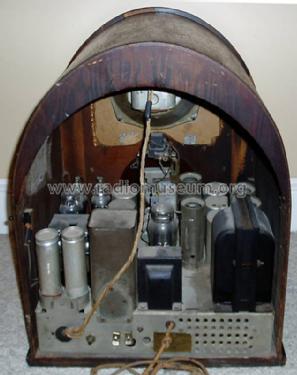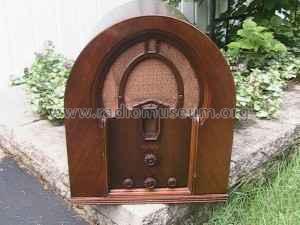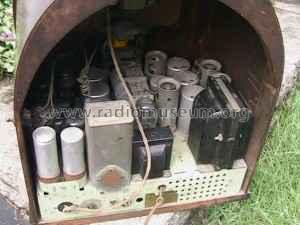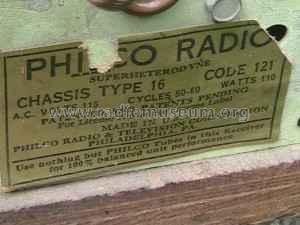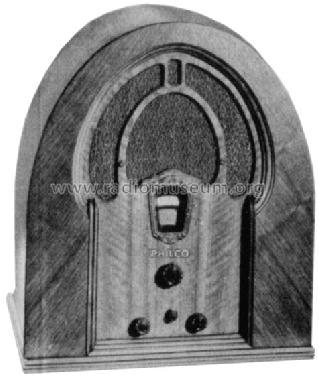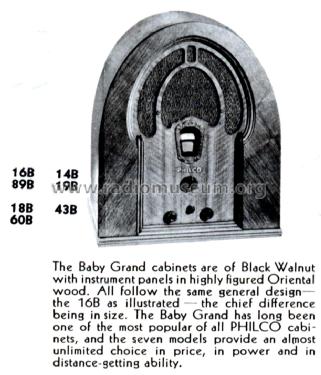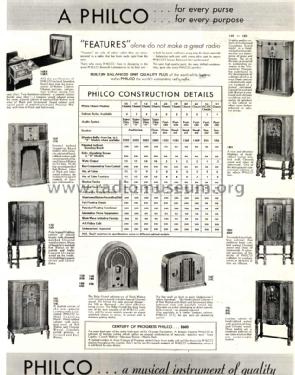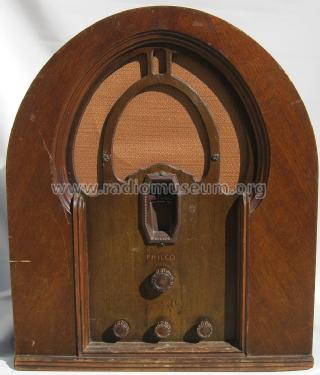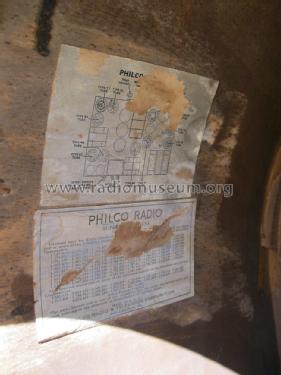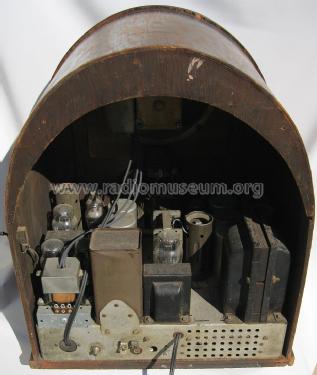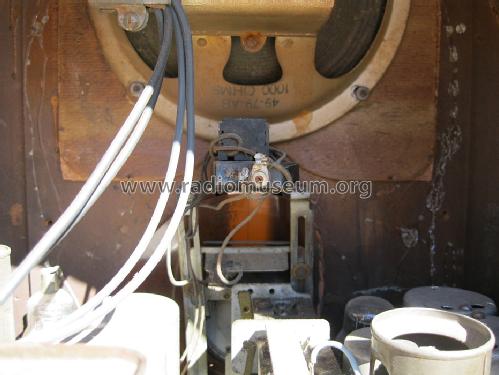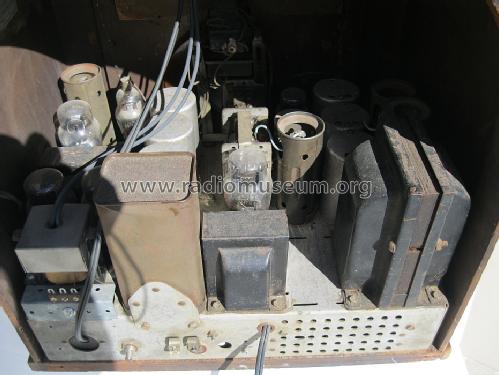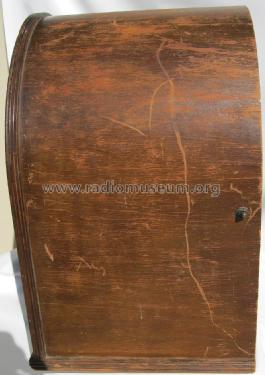16B 16/16A-121 Version 1
Philco, Philadelphia Stg. Batt. Co.; USA
- País
- Estados Unidos
- Fabricante / Marca
- Philco, Philadelphia Stg. Batt. Co.; USA
- Año
- 1933/1934
- Categoría
- Radio - o Sintonizador pasado WW2
- Radiomuseum.org ID
- 118866
Haga clic en la miniatura esquemática para solicitarlo como documento gratuito.
- Numero de valvulas
- 11
- Principio principal
- Superheterodino en general; ZF/IF 460 kHz
- Gama de ondas
- OM y más de dos OC
- Tensión de funcionamiento
- Red: Corriente alterna (CA, Inglés = AC) / 115 Volt
- Altavoz
- Altavoz electrodinámico (bobina de campo) / Ø 10 inch = 25.4 cm
- Potencia de salida
- 10 W (unknown quality)
- Material
- Madera
- de Radiomuseum.org
- Modelo: 16B 16/16A-121 [Version 1] - Philco, Philadelphia Stg. Batt
- Forma
- Sobremesa tipo Capilla (upright, round top or pinted arch, not rounded edges only).
- Ancho, altura, profundidad
- 16.5 x 19.5 x 12.8 inch / 419 x 495 x 325 mm
- Anotaciones
-
The first Philco 16B was introduced in June, 1933 as a 1933-model-year radio. It is an 11-tube, 5-band cathedral-style radio that used the early chassis 16-121 with an 80 rectifier tube. It had dual-IF amps and a squelch circuit that could be disabled with a switch on the right rear of the cabinet.
General Notes about the Philco Model 16 radios:
The model 16 series were high-end multiband radios. The early chassis used in 1933-34 had five bands covering 520 kHz to 23 MHz, and also included a QAVC ("quiet automatic volume control") squelch circuit to silence noise between stations (with a switch on the side and a control on the back to adjust the QAVC). The late version (1934-35) of the chassis covered a similar tuning range, but with only four bands, and eliminated the QAVC feature. Both the early and late chassis used a type 80 rectifier tube for the more compact 16B models, and a type 5Z3 for larger models. Both chassis included a shadow meter (tuning aid). Both chassis also were available in a version for 25-40 Hz power, and these chassis are marked as "16A" (where the -A suffix is a chassis suffix, not to be confused with the cabinet suffix on the main model number).
The chassis codes are as follows:
Code 121: early chassis with 80
Code 122: early chassis with 5Z3
Code 123: unknown
Code 125: late chassis with 80
Code 126: late chassis with 5Z3
Code 127: unknown
There were fifteen versions of model 16 in different cabinet styles over a three year span: four versions of the 16B cathedral/tombstone, three versions of the 16L lowboy, four versions of the 16X floor-type console, three versions of the 16RX chairside, and a special 16CPX chairside.
Version 1 (1933-34) of model 16B was a cathedral (early chassis); version 2 (1934) was a gently peaked tombstone (early chassis); version 3 (1934) was a slightly updated tombstone with a somewhat more steeply peaked top (late chassis); version 4 (1935) is a flat-topped shouldered tombstone (late chassis).
The early version (1933-34) of the 16L lowboy has four vertical bars through the speaker opening and an arched control panel (early chassis). The middle version (1934) has V-shaped bars in the speaker opening and hexagonal knobs (early chassis). The late version (1934-35) had the same cabinet as the middle, but with the late chassis.
Version 1 (1933) of the 16X console had a large open speaker grill on an inclined sounding board (early chassis). Version 2 (1934) had three round vertical bars in front of the speaker opening and patterned moulding around the top of the cabinet (early chassis). Version 3 (1934) had a more "modern" style with three square vertical bars in front of the speaker and no moulding around the top (early chassis). Version 4 (1934-35) kept the same cabinet, but used the late chassis.
The early version (1933-34) of the 16RX chairside had a control unit on legs with a top that swiveled to reveal the controls and a large separate speaker cabinet (early chassis). Version 2 (1934) had a more modern design, the control unit having no legs (or very short) and the speaker cabinet having a lightning bolt pattern on the speaker grill (early chassis). Version 3 (1934-35) kept the same cabinet, but used the late chassis.
The 16CPX was a special chairside model commemorating the "Century of Progress" and is rare or nonexistant today. The modern-style cabinets had veneers of Madagascar ebony and myrtle burl, with catalin and stainless steel trim. Only 750 units were manufactured. The 16CPX has the early chassis.Stein "Cathedral & Tombstone Radios" lists only 2 bands.
- Precio durante el primer año
- 75.00 $
- Procedencia de los datos
- Philco Radio 1928-1942
- Referencia esquema
- Rider's Perpetual, Volume 4 = ca. 1934 and before
- Mencionado en
- Collector's Guide to Antique Radios (6th edition)
- Documentación / Esquemas (1)
- Machine Age to Jet Age II (Philco 1928-36 Wiring Diagrams, Parts Lists, and Essential Service Data)
- Documentación / Esquemas (2)
- Cathedral & Tombstone Radios (page 190.)
- Documentación / Esquemas (3)
- Philco Folder for 1933/34.
- Autor
- Modelo creado por Konrad Birkner † 12.08.2014. Ver en "Modificar Ficha" los participantes posteriores.
- Otros modelos
-
Donde encontrará 4120 modelos, 2228 con imágenes y 3768 con esquemas.
Ir al listado general de Philco, Philadelphia Stg. Batt. Co.; USA
Colecciones
El modelo 16B es parte de las colecciones de los siguientes miembros.


